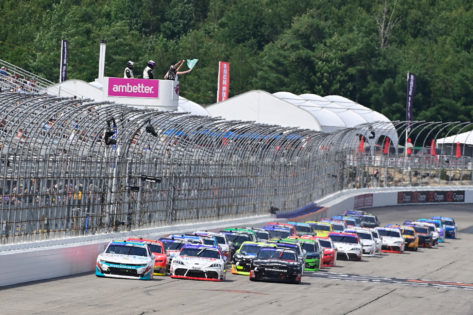In the hallowed halls of NASCAR history, legends aren’t born in the spotlight—they’re forged in the crucibles of Xfinity and Truck Series races. Names like Dale Earnhardt Jr., Kyle Busch, and Joey Logano didn’t emerge from the Cup Series; they climbed a ladder built on grit, determination, and the raw passion of lower-tier racing. Today, that ladder is crumbling under the weight of financial negligence, yet the spirit of these developmental series remains unbroken.
As the 2025 season roars, an unexpected narrative is emerging. While the Cup Series struggles with sponsorship and financial stability, the Xfinity Series is experiencing a renaissance that defies expectations. The numbers tell a compelling story: Xfinity races at Homestead drew 1.16 million viewers in 2025, a staggering 46% increase from the Richmond race in 2024. Through the series, CW has consistently pulled in over 1.286 million viewers, marking a 30% year-over-year growth that outpaces the premier Cup Series.
The financial disparity couldn’t be more stark. At the Las Vegas weekend, the purse breakdown reveals a troubling reality. The Cup Series boasts an impressive $11,055,250, while the Xfinity Series scrapes by with just $1,651,939—a drop of $149,339 from the previous year. The Truck Series fares even worse, competing for a mere $782,900. This isn’t just a numbers game; it’s a sustainability challenge that threatens the very foundation of NASCAR’s future.
Xfinity Series at Homestead had 1.160M viewers, up 46% vs. race 6 (Richmond) in ‘24 & up 42% vs. race 6 (COTA) in ‘23
Through 6 races in 2025, The CW is averaging 1.286M viewers, up 30% YoY & has been up 9% or more in every race. pic.twitter.com/lj8TrHUBdf
— Bryan Mapes (@IAmMapes) March 25, 2025
Veteran drivers aren’t shy about calling out the issue. Joey Logano’s 2024 revelation still echoes loudly: “I get paid to drive a Cup car. That’s great. But if I want to drive an Xfinity car or a Truck, I have to pay.” It’s a stunning admission that highlights the broken financial structure preventing young talents from breaking through. Kyle Larson further amplified the concern, noting, “I bet you the top four drivers in the World of Outlaws Sprint Car Series are making more money than a third to half of the Cup Series guys.”
Speaking of talents in the Xfinity Series, we have the likes of Connor Zilisch, Carson Kvapil, William Sawalich, Nick Sanchez, and Taylor Gray all entering their rookie seasons in 2025. A total of eight rookies will be competing for the Rookie of the Year honors, and the ratings clearly indicate that these drivers are creating the buzz around the second division of NASCAR racing.
The viewership surge tells a different story of resilience. While the Cup Series grapples with sponsorship challenges—Forbes reported a 13% drop in sponsorship money in 2024—the Xfinity Series is capturing the audience’s imagination. The series has seen viewer increases in every single race of the 2025 season, with a consistent 9% or more growth. It’s a testament to the raw talent and competitive spirit that continue to define NASCAR’s lower divisions.
Now we’re aware that CW has had trouble with their affiliate program and access to the NASCAR audience. However, they are bringing about positive changes within the sport, and once their streaming setup is up and running, we might see even better numbers. But here’s the hook that keeps fans on the edge of their seats: this isn’t just about money. It’s about the future of racing.
NASCAR’s Recurring Financial Battles
The secondary angle is equally compelling. This isn’t the first time NASCAR has faced a developmental series crisis. Historical parallels show that some of the greatest drivers emerged from seemingly insurmountable challenges.
NASCAR has experienced fiscal difficulties which repeat themselves across its history. When the economy experienced hardship in 2008, Brian France, at the time served as NASCAR’s chairman while contending with similar problems to those NASCAR is facing currently. Back then, the industry faced declining manufacturer support because General Motors faced a $2.5 billion quarterly deficit, and Ford held approximately $24.5 billion in debt. NASCAR faces no exemption from economic challenges, according to the remarks made by France during that period, which remain relevant today: “NASCAR as an industry is not immune. We have to work very hard to be good partners and work through these challenging times.”
The parallels are striking. Economic pressures during the 2008 crisis demonstrated the same force that today’s Xfinity and Truck Series experienced for their financial stability. Todd Duerr at Ford candidly explained in 2008 statements that still hold true today about the problem of defending racing investments during corporate cash loss situations. Today, the same situation resonates with teams like Joe Gibbs Racing, which is battling with the same sponsorship difficulty as it struggles to keep a single major sponsor throughout the season.
NASCAR’s historical philosophy persists through circumstances since the organization continuously makes modifications instead of collapsing. It has to be noted that NASCAR’s key partner, GEICO, has pulled the plug on its spending, moreover, the Xfinity brand has announced that it won’t return as a title sponsor for the second tier series beyond 2025. Adding another layer of complexity is the anti-trust lawsuit NASCAR is facing after 23XI Racing and Front Row Motorsports decided to take them to the court after disagreements over charter deal.
It is indeed hard to predict what NASCAR as a sport would look like one year down the line. This makes it even difficult for the governing body to map out a plan to tackle the ongoing issues across the three series.
The post Despite Snubbing Them of Millions, NASCAR Series Outruns Cup Series Amidst Rising Rookie Star Power appeared first on EssentiallySports.
